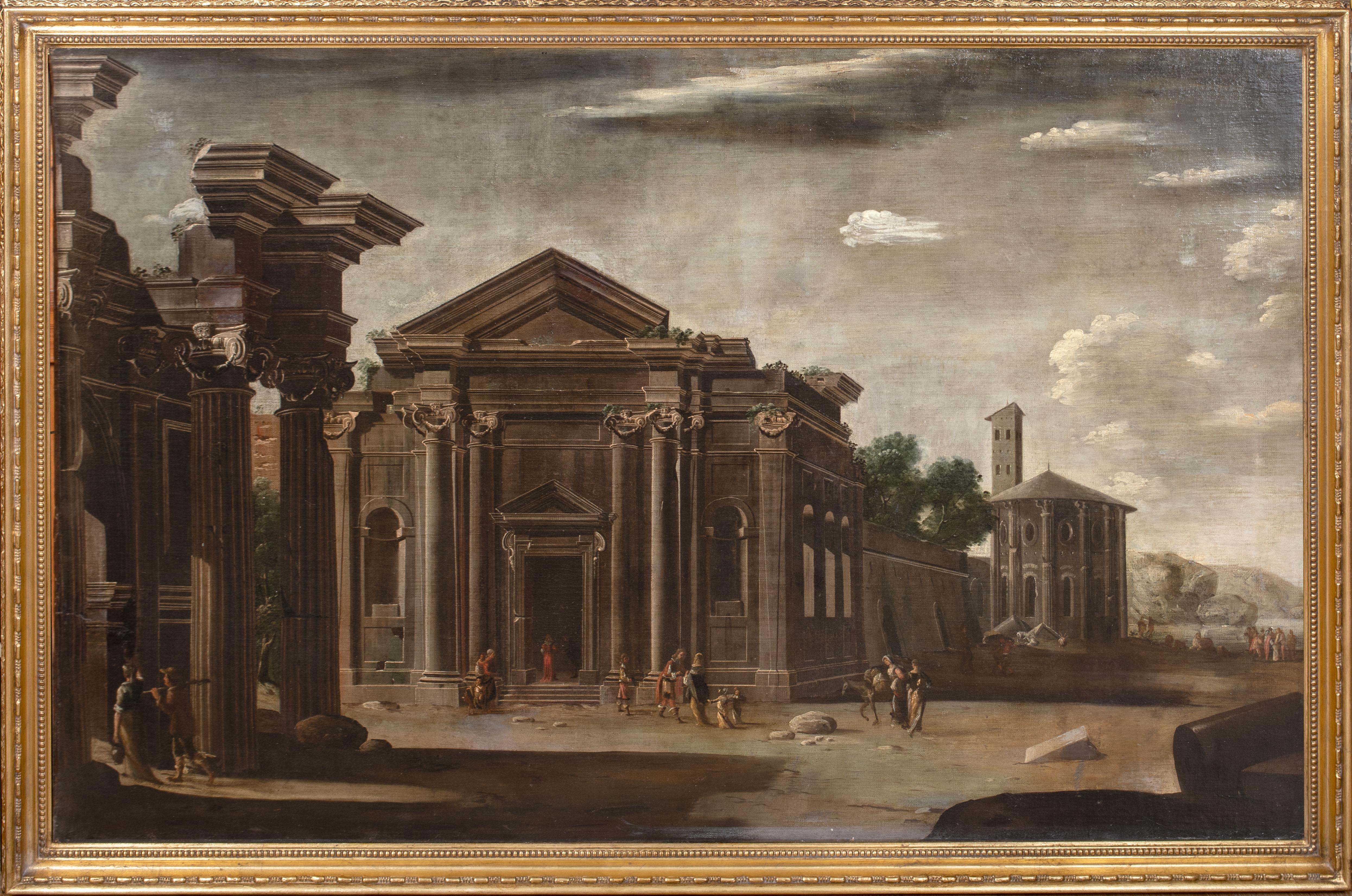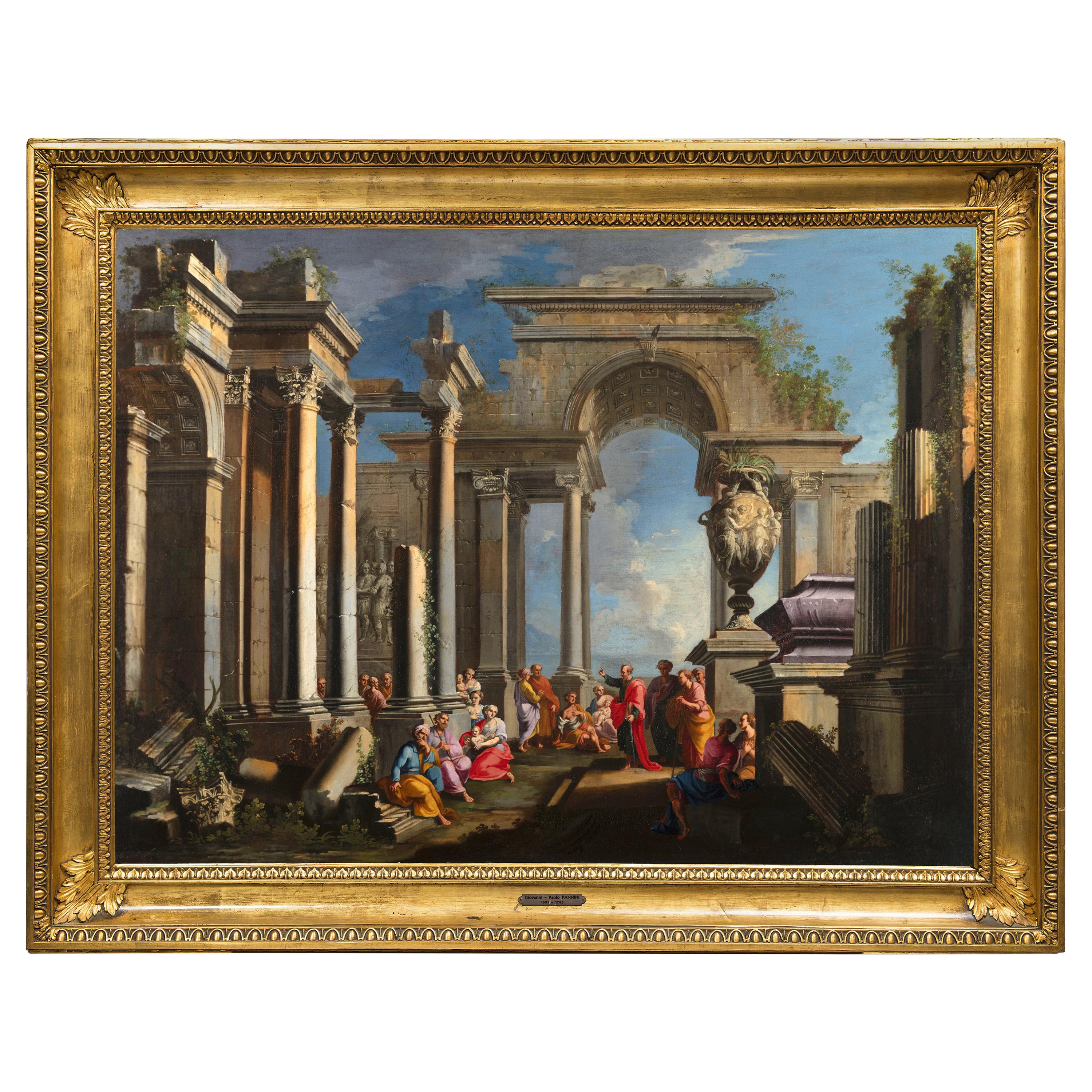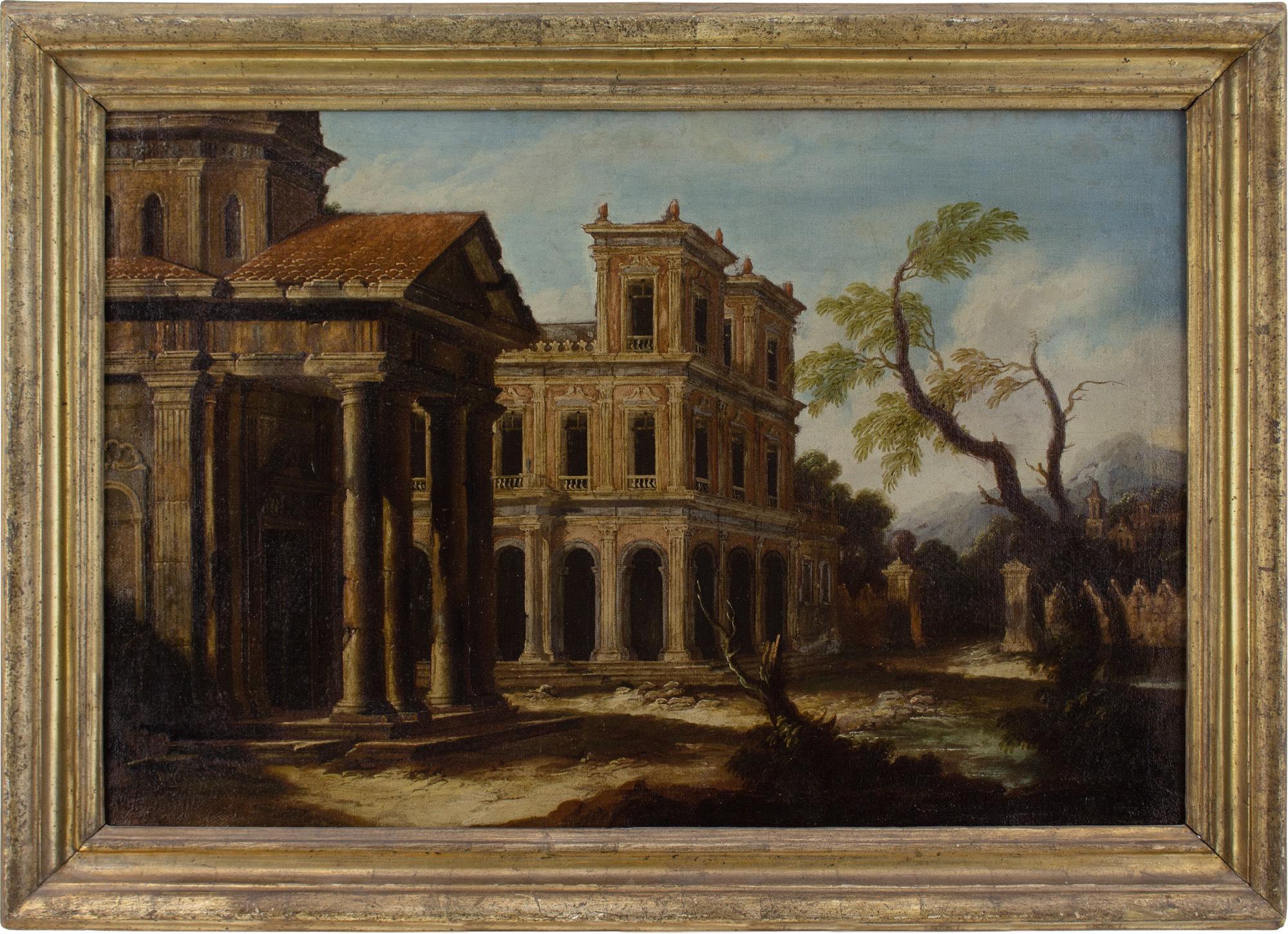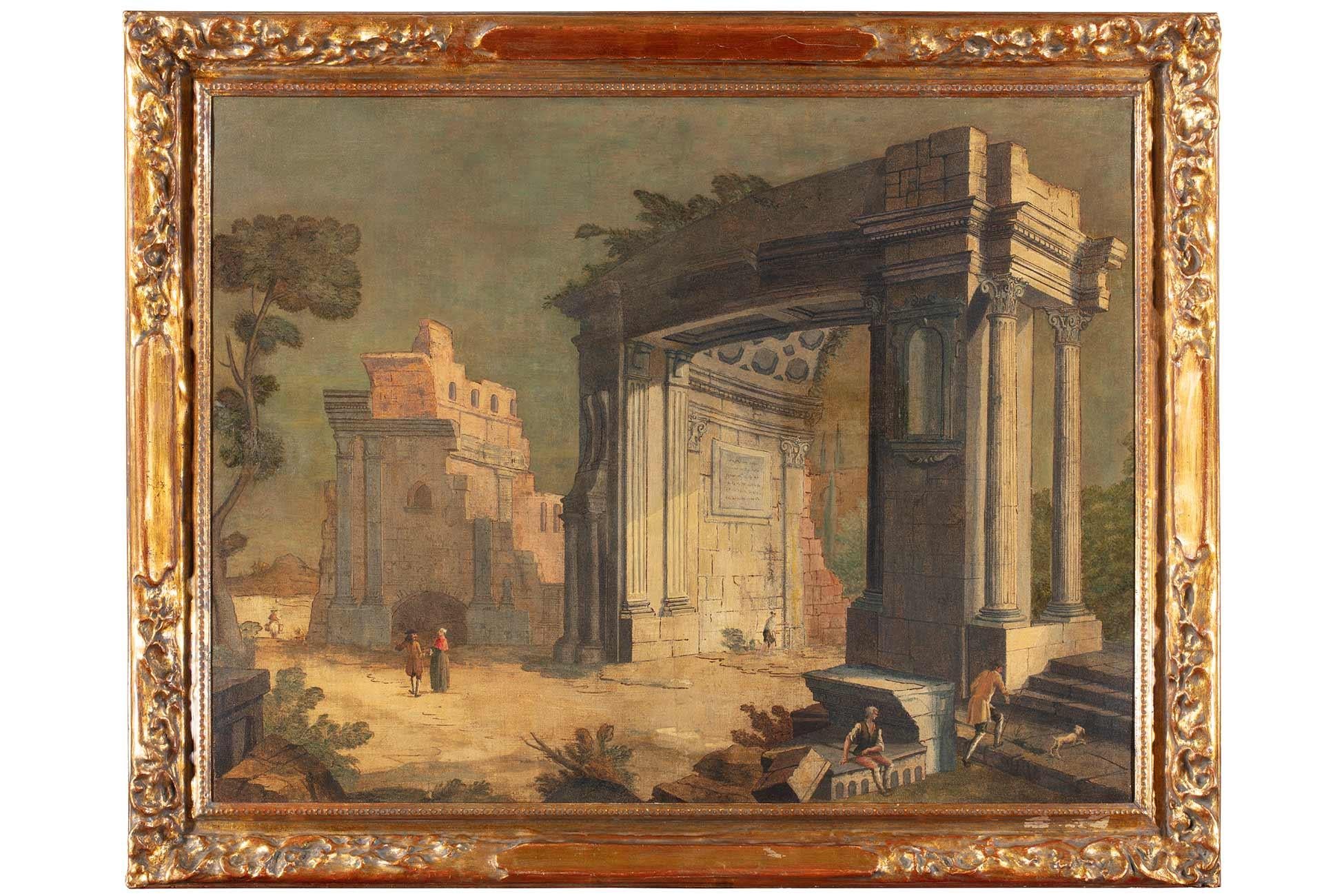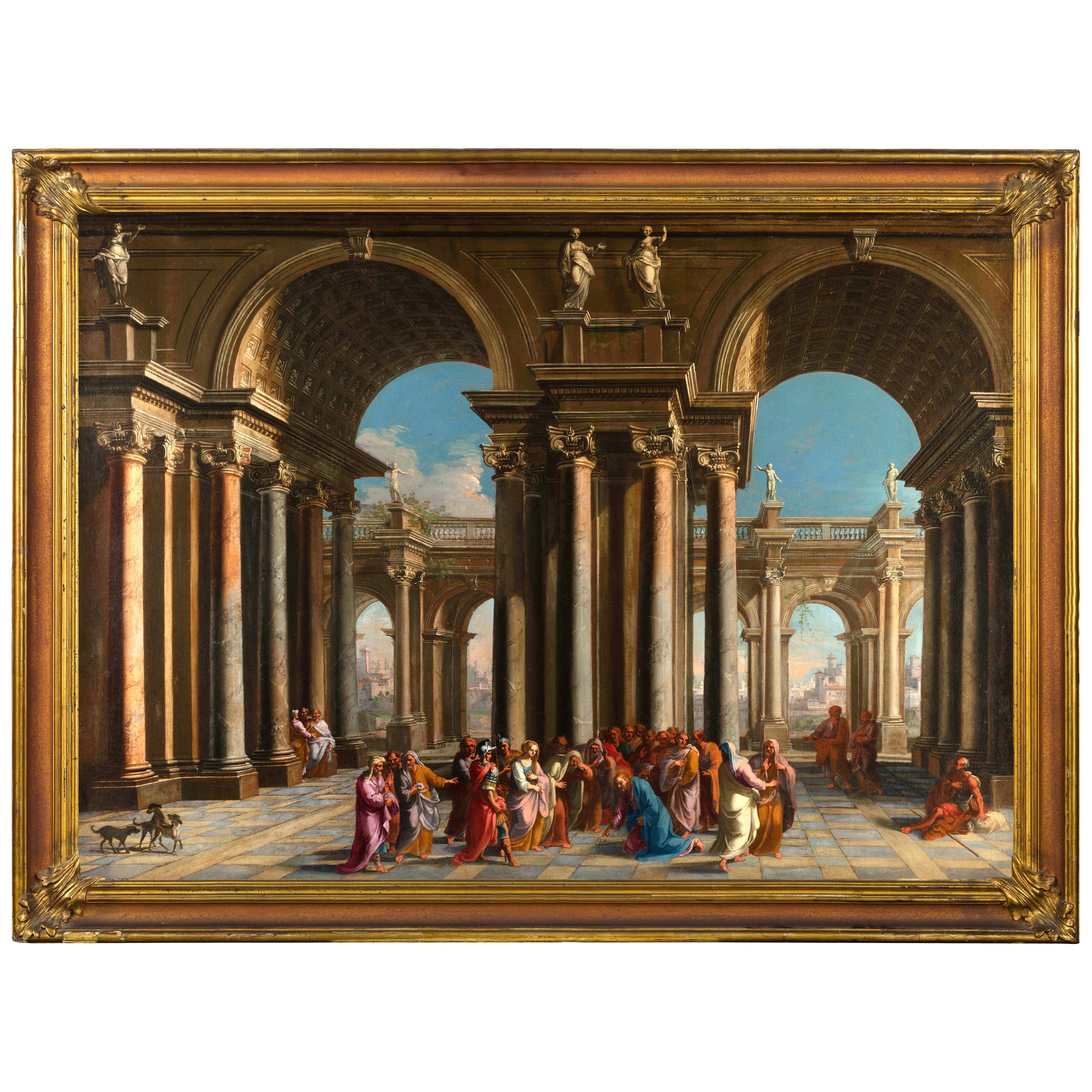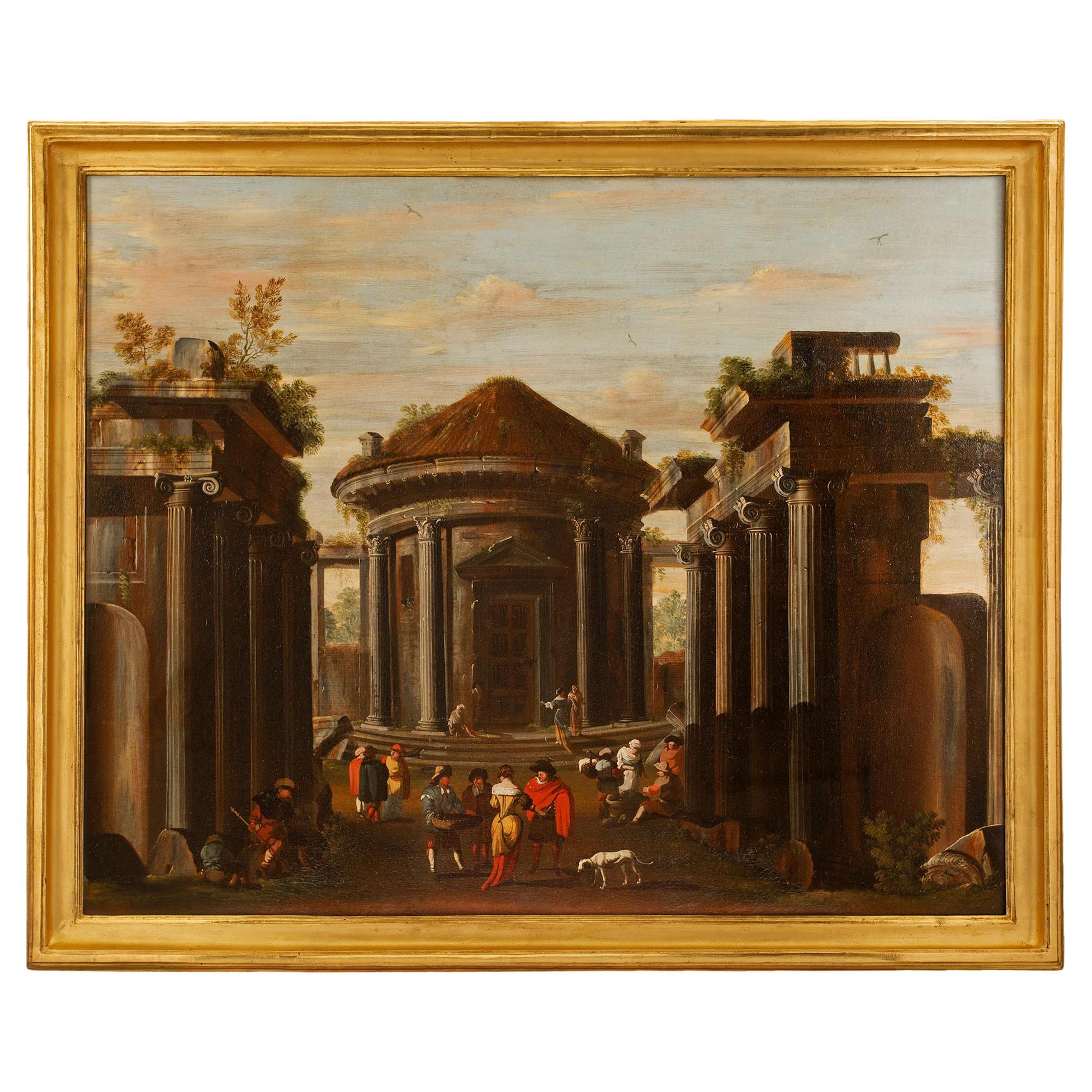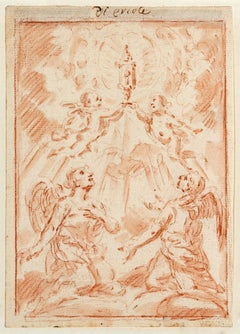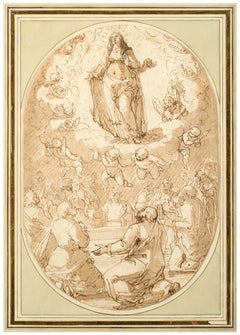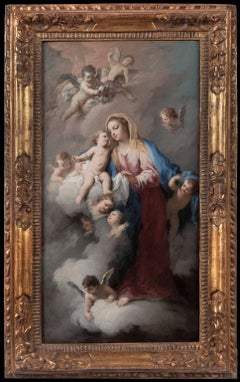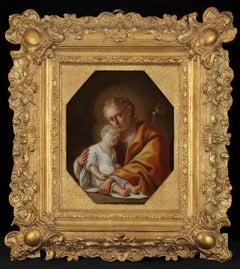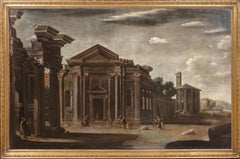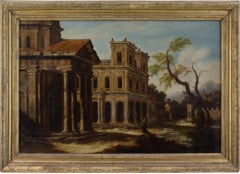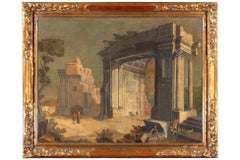Items Similar to An Architectural Capriccio with the Preaching of an Apostle
Want more images or videos?
Request additional images or videos from the seller
1 of 6
Giovanni Paolo PaniniAn Architectural Capriccio with the Preaching of an ApostleCirca 1711 - 1712
Circa 1711 - 1712
$85,000
£64,559.59
€74,587.66
CA$119,130.57
A$133,329.51
CHF 69,587.76
MX$1,625,932.79
NOK 890,628.61
SEK 843,094.04
DKK 556,637.84
Shipping
Retrieving quote...The 1stDibs Promise:
Authenticity Guarantee,
Money-Back Guarantee,
24-Hour Cancellation
About the Item
Provenance: Santambrogio Antichità, Milan; sold, 2007 to:
Filippo Pernisa, Milan; by whom sold, 2010, to:
Private Collection, Melide, Switzerland
De Primi Fine Art, Lugano, Switzerland; from whom acquired, 2011 by:
Private Collection, Connecticut (2011-present)
Literature: Ferdinando Arisi, “Ancora sui dipinti giovanili del Panini,” Strenna Piacentina (Piacenza, 2009): pp. 48, 57, 65, fig. 31, as by Panini
Ferdinando Arisi, “Panini o Ghisolfi o Carlieri? A proposito dei dipinti giovanili,” Strenna Piacentina, (Piacenza, 2010), pp. 100, 105, 116, fig. 101, as an early work by Panini, a variant of Panini’s painting in the Museo Cristiano, Esztergom, Hungary.
This architectural capriccio is one of the earliest paintings by Giovanni Paolo Panini, the preeminent painter of vedute and capricci in 18th-century Rome. The attribution to Panini has been endorsed by Ferdinando Arisi, and a recent cleaning of the painting revealed the artist’s signature in the lower right. Like many of his fellow painters working in Rome during his day, Panini was not a native of the Eternal City. He first trained as a painter and stage designer in his hometown of Piacenza and moved to Rome at the age of 20 in November 1711 to study figure painting. Panini joined the workshop of Benedetto Luti (1666-1724) and from 1712 was living on the Piazza Farnese. Panini, like many before and after him, was spellbound by Rome and its classical past. He remained in the city for the rest of his career, specializing in depicting Rome’s most important monuments, as well as creating picturesque scenes like this one that evoked the city’s ancient splendor.
The 18th century art historian Lione Pascoli, who likely knew Panini personally, records in his 1730 biography of the artist that when Panini came to Rome, he was already “an excellent master and a distinguished painter of perspective, landscape, and architecture.” Panini’s earliest works from this period still show the evidence of his artistic formation in Piacenza, especially the influence of the view painter Giovanni Ghisolfi (1623-1683). However, they were also clearly shaped by his contact in Rome with the architectural capricci of Alberto Carlieri (1672-1720), whose works have previously been confused with the works of the young Panini.
The present work is particularly interesting as an example of an imaginary scene that, rather than depicting real fragments of classical buildings and art, emerges completely from the mind of the young artist. The elaborate architectural ruins, including a partial colonnade on the left and a triumphal arch to the right, show clear signs of decay: the columns are chipped and the entablatures covered with plants dappled with orange flowers. The arches, with their articulated vaults, frame a distant view of a town on a hill that is seemingly separated by a body of water. This towering architecture also serves as the setting for a distinctly Roman religious scene that plays out in the middle ground. An apostle (probably Saint Peter) accompanied by two disciples is shown preaching to a crowd of women and children. In the foreground, two men in turbans approach the unfolding scene while a seated male figure looks on from below. The movement and energy of these figures, captured in their dynamic poses, reveals the artist’s early interest in studying models from the life.
Two of the most striking details of the composition are the relief fragment with Roman soldiers and the large historiated vase in the lower left. The extremely elaborate and detailed vase is particularly accomplished and is clearly a product of Panini’s close study of examples of antique sculpture found in abundance in Rome. It is decorated with a group of dancing bacchants that wind around the exterior of the vessel. Additionally, a sculpted satyr is shown climbing up one of the handles and peering down into the mouth of the vase, which contains a plant whose leaves splay out like a fountain. Although it is not based on a known classical example, the vase is likely a representation of a late Hellenestic kylix, like the Borghese Vase now in the Louvre (Fig. 1), which were produced in Athens to satisfy Roman demand for lavish villa and garden decorations.
Following the rediscovery of this painting in the early 2000’s, it was authenticated and published by Ferdinando Arisi, the leading scholar on Panini and the first to accurately reconstruct the artist’s early career. Arisi considered it a fully autograph work by Panini painted shortly after his arrival in Rome and compared it with the key painting of Panini’s early Roman period: the Preaching of an Apostle in the Museo Cristiano in Esztergom, Hungary. He considered our painting the best of several variants based on this prototype, describing it as “more delicate, mature, and brighter” than the Esztergom painting. Furthermore, Arisi suggested that the painting dates slightly after the work now in Esztergom, assigning it a date of c. 1711-1712.
The present painting also provides fascinating insight into Panini’s working processes early in his career when he is painting entirely independently, without the aid of a workshop or assistants. Panini clearly developed a repertoire of motifs (most likely a stock of drawings) that he frequently drew upon, as several components of the present painting—including the architectural frame, sculptural elements, and even several figures—are swapped out, re-elaborated on, or repeated in other works. The historiated vase frequently appears in Panini’s works of this period, each time with a newly designed relief, as does the pair of sculpted legs that stand above the triumphal arch. Additionally, Panini revisited the figural group of the apostle preaching to the people in the middle ground of the present work in a painting in a private collection. The lone male figure seated on the ground also reappears, in reverse, in versions of the Preaching of an Apostle in the Pinacoteca Civica Piceno and in a private collection.
- Creator:Giovanni Paolo Panini (1691 - 1765, Italian)
- Creation Year:Circa 1711 - 1712
- Dimensions:Height: 38.75 in (98.43 cm)Width: 28.75 in (73.03 cm)
- Medium:
- Movement & Style:
- Period:
- Condition:
- Gallery Location:New York, NY
- Reference Number:1stDibs: LU1024578041
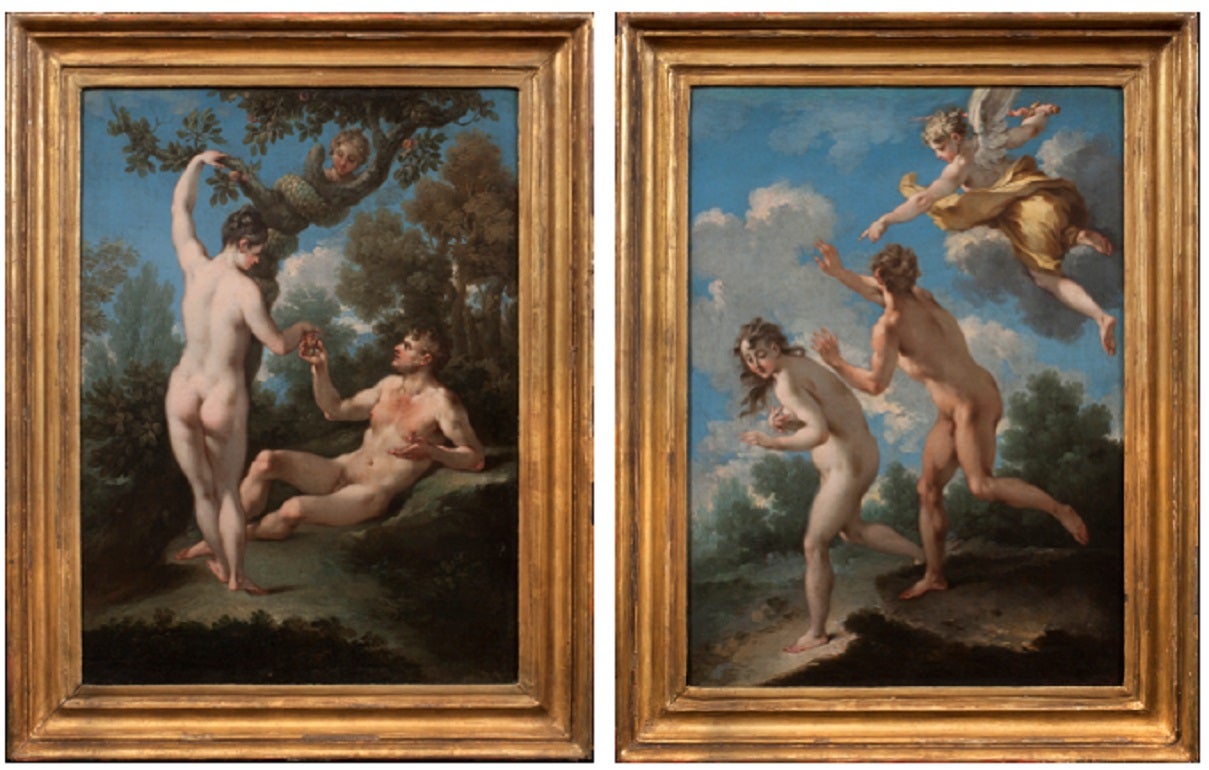
About the Seller
5.0
Recognized Seller
These prestigious sellers are industry leaders and represent the highest echelon for item quality and design.
Established in 1997
1stDibs seller since 2012
22 sales on 1stDibs
Typical response time: 8 hours
- ShippingRetrieving quote...Shipping from: New York, NY
- Return Policy
Authenticity Guarantee
In the unlikely event there’s an issue with an item’s authenticity, contact us within 1 year for a full refund. DetailsMoney-Back Guarantee
If your item is not as described, is damaged in transit, or does not arrive, contact us within 7 days for a full refund. Details24-Hour Cancellation
You have a 24-hour grace period in which to reconsider your purchase, with no questions asked.Vetted Professional Sellers
Our world-class sellers must adhere to strict standards for service and quality, maintaining the integrity of our listings.Price-Match Guarantee
If you find that a seller listed the same item for a lower price elsewhere, we’ll match it.Trusted Global Delivery
Our best-in-class carrier network provides specialized shipping options worldwide, including custom delivery.More From This Seller
View AllAngels in Adoration
Located in New York, NY
Provenance: Private Collection, USA.
This drawing is by Ercole Procaccini the Younger, who represents the final generation of painters in the storied Procaccini family. The son of C...
Category
Early 17th Century Baroque Drawings and Watercolor Paintings
Materials
Paper, Chalk
The Assumption of the Virgin
Located in New York, NY
Provenance:
Unidentified collector’s mark “D.G.R,” lower right (Lugt 757b)
Wilhelm Suida (1877–1959), New York; by descent to:
Robert L. and Bertina Suida Manning, New York, until 1996
Private Collection, USA
This impressive drawing of the Assumption of the Virgin is the work of the Genoese artist Giovanni Battista Paggi. The son of a nobleman, Paggi received a humanist education and was a self-taught artist. According to Paggi’s first biographer, Raffaele Soprani, it was only after encountering Luca...
Category
16th Century Old Masters Figurative Drawings and Watercolors
Materials
Paper, Ink, Pen
Madonna and Child with Angels in the Clouds
Located in New York, NY
Provenance: Charles H. and Virginia Baldwin, Claremont, Colorado Springs, Colorado ca. 1907-1934; thence by descent until sold in 1949 to:
Charles Blevins Davis, Claremont (renamed Trianon), Colorado Springs 1949 -until gifted in 1952 to:
The Poor Sisters of Saint Francis, Trianon, Colorado Springs, 1952 until acquired, 1960, by:
John W. Metzger, Trianon, renamed as the Trianon School of Fine Arts, Colorado Springs, 1960-1967; when transferred to:
The Metzger Family Foundation, Trianon Art Museum, Denver, 1967 - 2004; thence by descent in the Metzger Family until 2015
Exhibited: Trianon Art Museum, Denver (until 2004)
The present work is a spectacular jewel-like canvas by Amigoni, rich in delicate pastel colors, most likely a modello for an altarpiece either lost or never painted. In it the Madonna stands firmly upon a cloud in the heavens, her Child resting on a delicate veil further supported by a cloud, as he gently wraps his arm around his mother’s neck. From above angels prepare to lower flowers and a wreath, while other angels and seraphim surrounding the two joyfully cavort.
Dr. Annalisa Scarpa, author of the forthcoming monograph on Jacopo Amigoni...
Category
18th Century and Earlier Figurative Paintings
Materials
Canvas, Oil
Joseph Holding the Christ Child
By Pietro Bardellino
Located in New York, NY
Provenance: Private Collection, Argentina.
A work of great delicacy and intimacy, this small painting on copper by Pietro Bardellino treats a subject which grew in popularity during the Baroque period: Saint Joseph and the Christ child...
Category
18th Century Baroque Paintings
Materials
Copper
Two Scenes of Diana and Actaeon (a pair)
By Giovanni Battista Viola
Located in New York, NY
Provenance:
Robert L. and Bertina Suida Manning, New York, until 1996
Private Collection, USA
Giovanni Battista Viola was born in Bologna a...
Category
17th Century Baroque Landscape Paintings
Materials
Copper
View of St. John’s Cathedral, Antigua
Located in New York, NY
Provenance:
Robert Hollberton, Antigua, ca. 1841
Private Collection, New York
The present painting depicts Old St. John’s Cathedral on the island of Antigua. The church was erected in the 1720s on the designs of the architect Robert Cullen. It measured 130 feet by 50 feet with north and south porches 23 x 20 ½ feet. The tower, 50 feet high with its cupola, was added in 1789. The church was elevated to the status of a cathedral, but disaster struck in the form of an earthquake that destroyed the building on 8 February 1843. A memorandum of that date relates the event:
“On Wednesday, 8th February, 1843, this island was visited by a most terrific and destructive earthquake. At twenty minutes before eleven o’clock in the forenoon, while the bell was ringing for prayers, and the venerable Robert Holberton was in the vestry-room, awaiting the arrival of persons to have their marriage solemnized, before the commencement of the morning service, the whole edifice, from one end to the other, was suddenly and violently agitated. Every one within the church, after the first shock, was compelled to escape for his life. The tower was rent from the top to the bottom; the north dial of the clock precipitated to the ground with a dreadful crash; the east parapet wall of the tower thrown upon the roof of the church; almost the whole of the north-west wall by the north gallery fell out in a mass; the north-east wall was protruded beyond the perpendicular; the altar-piece, the public monument erected to the memory of lord Lavington, and the private monuments, hearing the names of Kelsick, Warner, Otley, and Atkinson, fell down piecemeal inside; a large portion of the top of the east wall fell, and the whole of the south-east wall was precipitated into the churchyard, carrying along with it two of the cast-iron windows, while the other six remained projecting from the walls in which they had been originally inserted; a large pile of heavy cut stones and masses of brick fell down at the south and at the north doors; seven of the large frontpipes of the organ were thrown out by the violence of the shock, and many of the metal and wooden pipes within displaced; the massive basin of the font was tossed from the pedestal on which it rested, and pitched upon the pavement beneath uninjured. Thus, within the space of three minutes, this church was reduced to a pile of crumbling ruins; the walls that were left standing being rent in every part, the main roof only remaining sound, being supported by the hard wood pillars.”
The entrance from the southern side into the cathedral, which was erected in 1789, included two imposing statues, one of Saint John the Divine and the other of Saint John the Baptist in flowing robes. It is said that these statues were confiscated by the British Navy from the French ship HMS Temple in Martinique waters in 1756 during the Seven Years’ War and moved to the church. The statues are still in situ and can be seen today, much as they appeared in Bisbee’s painting, but with the new cathedral in the background (Fig. 1).
Little is known of the career of Ezra Bisbee. He was born in Sag Harbor, New York in 1808 and appears to have had a career as a political cartoonist and a printmaker. His handsome Portrait of President Andrew Jackson is dated 1833, and several political lithographs...
Category
19th Century Old Masters Landscape Paintings
Materials
Canvas, Oil
You May Also Like
Architectural Capriccio Of Ancient Rome, 17th Century VIVIANO CODAZZI
Located in Blackwater, GB
Architectural Capriccio Of Ancient Rome, 17th Century
school of Viviano CODAZZI (1604-1670)
Huge 17th Century Italian Old Master view of an Architectural Capriccio with figures out...
Category
17th Century Portrait Paintings
Materials
Oil, Canvas
Alberto Carlieri, Painting with Architectural Capriccio
By Alberto Carlieri
Located in IT
Alberto Carlieri (Rome 1672-1720)
"Architectural capriccio with the preaching of Saint Paul in the Areopagus of Athens"
Oil on canvas, measures with...
Category
Antique Late 17th Century European Baroque Paintings
Materials
Canvas
Late 17th-Century Italian School, Architectural Capriccio With Portico
Located in Cheltenham, GB
This late 17th-century Italian oil painting depicts a view with distinctive Italianate architecture including a building with an iconic portico and pediment.
Popular in mid-17th-cen...
Category
1680s Italian School Landscape Paintings
Materials
Oil, Canvas
18th Century by Antonio Stom Architectural Capriccio Oil on Canvas_
By Antonio Stom
Located in Milano, Lombardia
Antonio Stom (Venice, Italy, c. 1688 - 1734)
Title: Architectural Capriccio
Medium: Oil on canvas
Dimensions: without frame 88 x 113 cm - with frame 106 x 132 cm
Carved, sculpted and...
Category
Early 18th Century Old Masters Landscape Paintings
Materials
Canvas, Cotton Canvas, Oil
$18,970 Sale Price
28% Off
Alberto Carlieri, Capriccio with Christ and the Adulteress, Oil on Canvas
By Alberto Carlieri
Located in IT
Alberto Carlieri (Italy-Roma 1672-1720), "Christ and the adulteress",
Oil on canvas, with frame cm H 115 x L 151 x 6.5, only canvas H 98.5 x L 135 cm...
Category
Antique Late 17th Century Italian Baroque Paintings
Materials
Canvas
Italian Early 18th Century Roman Oil on Canvas, of an Architectural Theme
Located in West Palm Beach, FL
A very attractive Italian early 18th Century Roman oil on canvas, of an architectural theme. The painting is of a central round pavilion amidst ruins accente...
Category
Antique 18th Century Italian Paintings
Materials
Canvas, Giltwood
More Ways To Browse
Antique Soldier Painting
18th Century Oil Painting Garden
Oil Painting Capriccio
Apostles Painting
Fig Still Life
Roman Soldier Sculpture
18th Century Plant Stand
Dancing Satyr
18th Century Capriccio
Soldier Vase
Giovanni Paolo Panini
Olaosun Oluwapelumi
Peter Max Mixed Media Umbrella Man
Prometheus Painting
Redhead Portrait
Robert Fawcett
Violin Player
Crespi Painting
